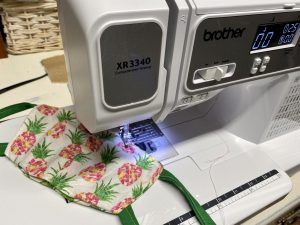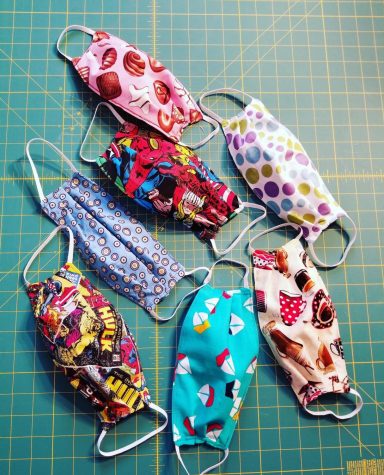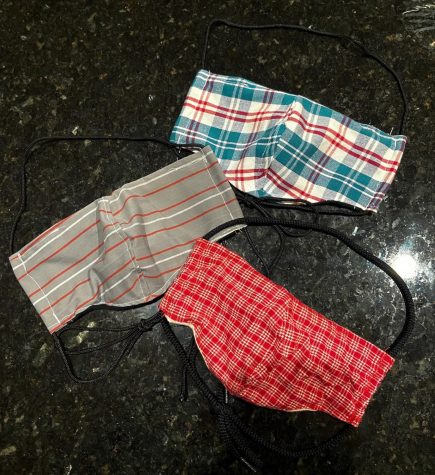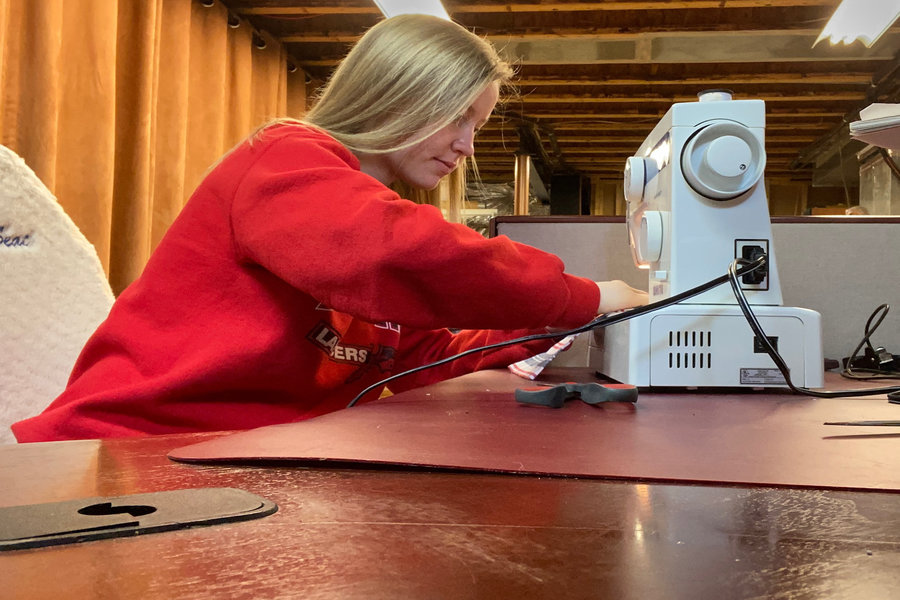“Sew” necessary: It’s time to make masks to help control spread of Covid-19
Jessica Young is sewing face masks to donate to FMH.
April 14, 2020
Remember when a mask used to be a refreshing skin treatment, a scary Halloween costume, or a Mardi Gras party accessory?
Before March 2020, no one would be likely to wear them in public. Some people would be afraid or even anxious just seeing people outside with a mask on.
In addition to time on distance learning, 1,000 piece puzzles and Zoom calls with friends, many teens are trying to find activities to keep themselves busy at home. One idea is making homemade face masks.
There are a variety of ways to make masks at home many in the Linganore community are being proactive. They are making a variety of masks using designs and instructions from the web.
At first there was confusion about the benefits of masks, but now they are recommended. The Center for Disease Control (CDC) advises, “The use of simple cloth face coverings to slow the spread of the virus and help people who may have the virus and do not know it from transmitting it to others.” Asymptomatic carriers could be spreading illness and not know it. Even though masks will not prevent the virus completely, they are still beneficial.
So many designs!
Face masks can come in all sorts of designs, styles, and patterns.
There are face masks that use elastic to stretch out to the ears. There are masks that use shoe laces that wrap around the top of the head like a headband and then tie at the neck. There are even masks that are very unusual and use the cup of a bra and its straps.
English teacher Natalie Rebetsky, who started the “Sewtherapy club,” has been sewing face masks after each day of distance learning/teaching.

Rebetsky sews masks for family and friends.
“I love to sew, and this is the perfect opportunity to help my family and friends. The design I chose has a lining to insert a coffee filter. I like making masks with unique patterns because I have a lot of fabric scraps at home. I gave one to my son in Florida, and it had flamingos on it.”
Junior Sierra Rossman has been sewing with 4H for a long time and has been making homemade masks as a way to keep busy. Her mom, Susan, and sister, Sydney, also enjoy sewing and have worked with her on this project.

“I joined the Frederick County Chapter of Project Linus on Facebook who had posted directions on how to make the masks that were approved and needed by FMH and other healthcare facilities in Frederick County,” said Susan Rossman. “To test directions, together with the girls, we cut and made 7 masks for the family.”
A friend who Susan Rossman graduated from high school with lives in Washington, D.C. and was afraid to leave her house. Rossman happily made her friend two masks and sent them to her–no charge. Knowing that her friend could now leave her home and get essential items because she felt safer with the masks was payment enough.
Not all mask designs require sewing. Some are using towels, tied at the ends using hair elastics, and attaching them by tying the towel to the back of their head.
Are homemade face masks helpful?
Homemade face masks may not be as protective as the recommended “N95” face masks, but they can still help to protect against the virus.
What makes the “N95” mask so great at protecting against the virus is that they are designed to achieve a very close facial fit and have very efficient filtration of airborne particles. The respirator blocks at least 95% of very small test particles. If properly fitted, the filtration capabilities of N95 respirators exceed those of handmade or other face masks.
It’s also important to remember that masks are not helpful unless they are worn properly. That applies to all face masks, homemade or not.
The correct way to wear a mask is that it should fit snugly but comfortably against the side of the face, be secured with ties or ear loops, include multiple layers of fabric, allow for breathing without restriction, and be able to be laundered and machine dried without damage or change to shape.
Not following this procedure could lead to getting the virus instead of avoiding it. If the mask is contaminated, touching your eyes, nose, or other access to inside the body could spread it.
With all this being said, there is also a right way to remove the masks. Individuals should be careful not to touch their eyes, nose, and mouth when removing their face covering and wash hands immediately after removal.
Helping the Healthcare workers
Since the homemade masks aren’t as protective as the N95, many healthcare workers and facilities accept homemade donations to use as a cover to their N95. Wearing a homemade cotton mask over top of the recommended N95 has been proven to lengthen the N95’s ability to protect against the virus. 
The Young family has taken on the challenge of sewing for the hospital. Linganore parent Keri Young is a retired nurse. She and her family have been sewing face masks to donate to Frederick Memorial Hospital and their hardworking employees.
“Having a nursing background, I knew that wearing a mask was going to help keep people safe and prevent the spread of the corona virus. Iv’e always believed that we should use our gifts and talents to help others. So knowing that my husband, daughter, and I could sew, we started to make masks.” said Young
The design that they use is one that they got from the “accepted donations” list on their website. The design is called “The deaconess.”
Masked emotions
When everyone is wearing masks, essential facial expressions are hidden, which makes us all a little more unsure.
One Business Insider article described how health professionals were taping photos of their faces on their hospital gear to make patients less frightened of the masked appearance.
“When I was in the post office, and everyone had face masks, I noticed we all didn’t say ‘Hello’ or smile. Everyone was alert and quiet. It is going to be hard to learn to express my feelings in other ways,” said Rebetsky. “It’s the same as coughing or sneezing. Everyone turns away. It could just be a regular sneeze!”

One NSA employee, who is required to wear a mask at work, is worried about others who refuse. Being in a high-risk group, he believes all people should wear masks–if not to protect themselves, then to protect others.
“It’s definitely a change seeing everyone wear masks and gloves. I went to the grocery store the other day and almost everyone was wearing them. I think it really puts into perspective how serious and how big of an impact the pandemic has on us all,” said Sierra Rossman.”
Some people refuse to wear masks because they are making a “personal choice.” That’s become a flash point for frustration.
“I think that wearing masks is an essential part of protecting ourselves and others from the coronavirus; therefore, when I see other people wearing them, I appreciate it greatly. When I see people in masks in my community, I see them as being respectful of others and their safety. I don’t think that it is something to fear, but instead something to encourage.” said Young.



